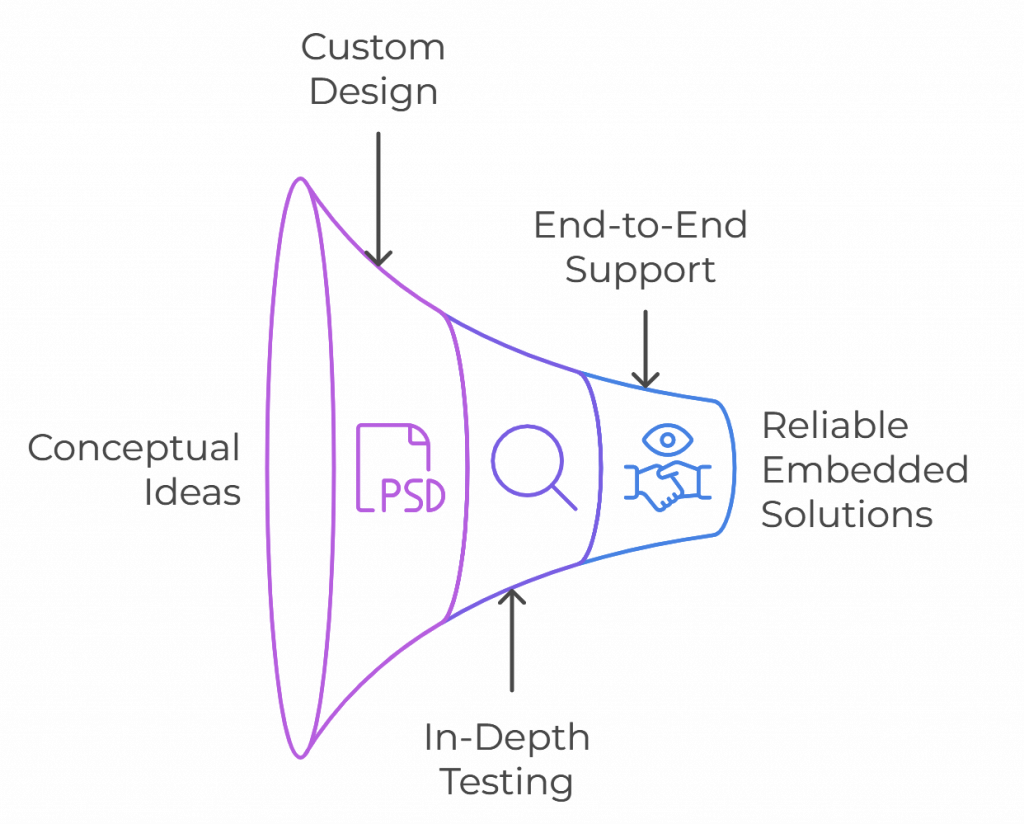Imagine systems that don’t just operate but empower – at Experion, we’re engineering tomorrow’s breakthroughs in embedded solutions. From powering life-saving medical devices to driving automotive innovation and industrial automation, embedded systems work tirelessly behind the scenes, bringing advanced technology to life in ways that are often unseen but deeply impactful.
What is an Embedded System?
An embedded system is like a specialized computer, purpose-built to perform a specific function within a larger mechanical or electrical setup. Unlike your everyday computer that can run a range of applications, embedded systems are designed to handle one or a few dedicated tasks with high efficiency and reliability. They power countless devices and applications, often working behind the scenes to keep everything from industrial machinery to medical equipment running smoothly. Thanks to their streamlined design, they’re known for energy efficiency, robustness, and real-time performance.
Key Components of an Embedded System
Each embedded system has a few essential building blocks that enable it to perform its dedicated function:
- Microprocessor or Microcontroller: This acts as the system’s brain, executing the instructions that bring the system to life.
- Memory: The place where data and instructions are stored, essential for performing tasks accurately.
- Input/Output Devices: These are the system’s way of interacting with the outside world, from sensors that capture data to actuators that take action based on that data.
- Power Supply: Provides the energy needed to run the system, often with an eye toward efficiency to conserve resources.
- Embedded Software: Directs the hardware, controlling how data is processed and how the system responds.
These components work together to make embedded systems effective, reliable, and capable of handling specific tasks with precision.
Types of Embedded Systems
Embedded systems are part of many of the devices we rely on daily, and they vary greatly depending on their application:
- Consumer Electronics: From smartphones and tablets to game consoles and digital cameras, embedded systems drive user experiences in consumer products.
- Automotive: In vehicles, embedded systems play essential roles in engine control, anti-lock brakes, airbags, and infotainment systems.
- Industrial Automation: Manufacturing processes use embedded systems for robotics, machine control, and programmable logic controllers (PLCs).
- Medical Devices: Life-saving devices like pacemakers and insulin pumps are powered by embedded systems.
- Aerospace and Defense: In mission-critical applications, embedded systems are integral to flight controls, missile guidance, and satellite systems.
Embedded Engineering: A Balance of Hardware and Software
Embedded engineering blends the art of hardware and software design to create systems that can meet specific needs while managing limitations. Embedded engineers are responsible for:
- System Design: Mapping out the architecture, choosing components, and defining how they interact.
- Hardware Design: Developing the physical elements, like microcontrollers and sensors.
- Software Development: Writing code that brings the system to life, managing everything from device drivers to application-level functions.
- Testing and Debugging: Thoroughly testing to ensure that systems work as intended, especially in real-time, where they often face strict timing constraints.
This combination of hardware and software know-how allows engineers to deliver solutions that are both practical and efficient.
Challenges in Embedded System Design
Creating embedded systems involves several unique challenges:
- Real-Time Constraints: Some systems must respond within milliseconds, which is essential for functions like automotive safety or medical monitoring.
- Resource Constraints: Limited memory, processing power, and energy mean designs have to be streamlined and efficient.
- Reliability and Safety: These systems often perform critical tasks, so they need to be highly reliable and safe.
- Security: As embedded systems become more connected, protecting them from cyber threats is essential.
Meeting these challenges is essential to ensure embedded systems continue to perform reliably, especially in high-stakes environments.
How Experion is Transforming Embedded Systems
Experion is making strides in the embedded systems field, helping companies turn unique concepts into reliable solutions. With expertise in both design and development, Experion works across industries to offer solutions that go beyond the standard, addressing client-specific needs with creativity and precision. Here’s what sets Experion apart:

- Custom Design and Development: Whether it’s developing a new embedded system from scratch or fine-tuning an existing design, Experion crafts solutions tailored to fit exact requirements.
- In-Depth Testing: Reliability is non-negotiable. Experion’s thorough testing process ensures each system can handle its real-world applications without missing a beat.
- End-to-End Support: From initial concept to ongoing support, Experion is there for the full journey, ensuring systems perform smoothly even after deployment.
Experion’s approach to embedded systems reflects our commitment to quality, innovation, and long-term support, helping clients succeed in industries where every detail matters. When it comes to embedded systems, Experion is your partner in turning ideas into lasting, high-impact innovations. Ready to innovate? Connect with us now and let’s bring your vision to life!

